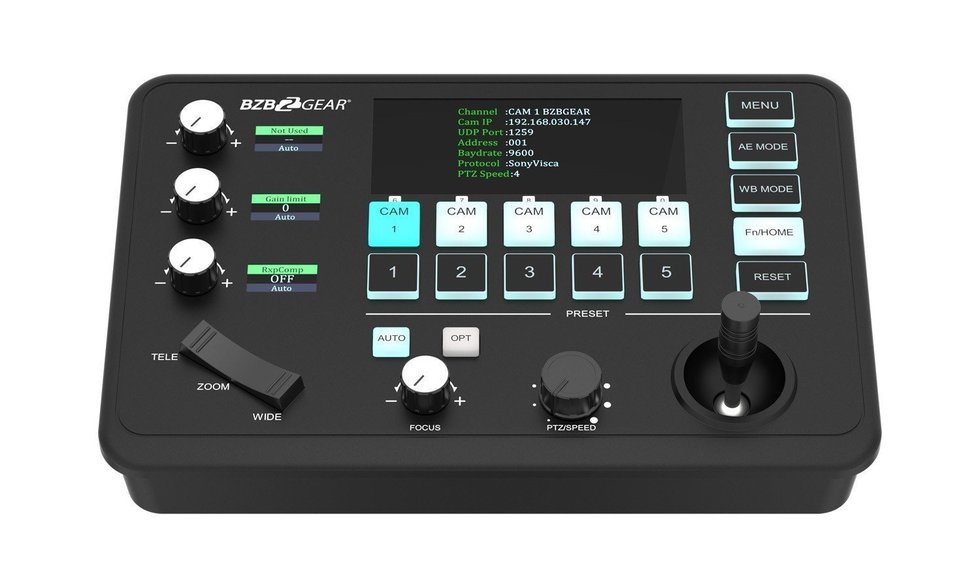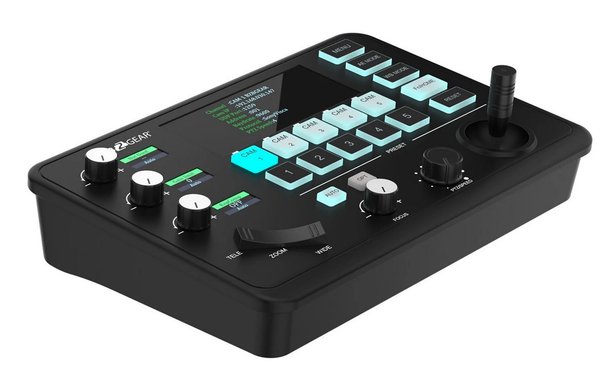The LCD screen shows what commands are being given … I am a fan of this feature because it helps train new people on the controller.
The Commander Jr has a familiar button layout and control; if you have ever used a PTZ controller, you will feel right at home. A large LCD screen dominates the controller’s center area, giving you status and making setup a breeze. The LCD screen also shows what commands are being given in the bottom right corner; this is becoming more common on controllers. I am a fan of this feature because it helps train new people on the controller. Sometimes it’s tough to understand what you are learning, and having some visual feedback that you have engaged the controls for those movements is super valuable. It is also helpful for people like me who use many controllers at different venues to figure out which controllers have the up and down inverted and which do not. Interestingly inverting up and down control was not a feature I could find in the menu on the Commander Jr. While not a deal breaker for me, I know people who prefer their PTZ controllers to operate like flight controls. According to BZBGEAR, a firmware update to implement inverted controls is currently in the works and will be available Q3 of this year.
The buttons on the Commander Jr have a tactile “click” when you press them, which gives you reliable feedback.
The menus are intuitive and easy to navigate. The joystick functions for menu navigation, making changes quick and easy. Moving the joystick to the right drills into the menu, or if you have changed a value, it saves that change. Left navigates back up a page in the menu while up and down navigate up and down the menu, or change selected values. There are multiple menus; holding the menu button for three seconds brings up the menu on the controller, while tapping the menu button will bring up the menu display on the output. This is important because there are some features only available in the display menu. For instance, if you mount a camera upside down, you can flip the image in the display menu but not in the controller menu.
The knobs are free spinning with no stops, which I do not prefer, but for a universal controller, this makes sense because each camera will have different graduations in those controls. However, it does make the knobs feel hard to get detail control on. For example, if you adjust the iris by turning the knob quickly 180 degrees, you will change the iris two stops. However, if you turn the knob slowly 180 degrees, it will change the iris 12 stops. This inconsistency makes it tough to get reliable control. Again, this may be a feature found in this budget-minded Commander Jr version, and a compromise not found on the more expensive models. Turning the knob slowly garnered the best results, which tends to be counterintuitive in a live production setting, where things happen fast. The function of the knobs can also change based on other selections. To keep things from getting confusing, each knob has a little LED screen that indicates what function it currently controls and its value. This is a much-appreciated feature because it brings clarity and confidence when you need to make changes.
I/O
For control connectivity, the Commander Jr has many options --- more than some other small controllers, including; options from serial RS232 over a serial DB9 connector, RS422 and RS485 over a Phoenix terminal, and LAN over an RJ45. Beyond those connections, it works with VISCA, UDP, and PELCO P/D control protocols. This should cover pretty much any control you may need.
Things To Like
One of the best things about this controller is its large buttons, which are clearly labeled, and the best combination of silicone buttons and tactile response I have ever used. Many controllers and devices have larger silicone rubber buttons, which seem great because they are large and clear. However, those buttons often have wiggle room in the housing, so pressing them sometimes reseats or shifts the button rather than engages it. This is an issue because this reseating feels tactilely the same as engaging the button. As an end user, you can’t tell if the button was engaged or just reseated because it feels similar. The buttons on the Commander Jr have a tactile “click” when you press them, which gives you reliable feedback. They are also backlit and have white and green backlights, so you know what camera you are using or when you trigger a preset recall.
When it comes to functionality, the preset controls are the star of the show. To record a preset, press and hold the number; to recall it, press the number. This single-button program and recall is great because it makes programming and recalling presets fast and intuitive. Some other controllers now require you to confirm that you want to recall a preset, which defeats the purpose because it takes too long.
I wish I got this level of service every time I called tech support with other companies.
The last thing to like about the BZBGear controller is the customer support; while the setup is straightforward, I missed a critical step and needed to call customer support. The support rep I spoke with was knowledgeable, very helpful, and got me squared away quickly. I wish that every time I called tech support with other companies, I got this level of service.
Conclusion
One of the significant issues with reviewing PTZ controllers is that it’s sometimes hard to nail down if something is a function of the controller or the camera. For this review, I was sent the Controller Jr and two BZBGear BG-VPTZ cameras, and I found this combination to work really well. After fixing my initial setup mistake, I found the Commander Jr easy to set up, intuitive to use, and takes up very little space on the table, making it an excellent option for churches with cramped tech areas. With an MSRP of $599.00, it’s a great option to pair with any BZBGear PTZ camera, but because it’s universal, it’s designed to pair well with pretty much any PTZ camera.
Where to buy the BZBGear Commander Jr >>
Learn more about the Commander Jr >>
Meet the BZBGear team and checkout their gear in person at Capture Summit '23 in Dallas, Aug. 7-9!
Join Capture partner BZBGear, dozens of expert presenters, along with hundreds of your fellow creatives for a deep-dive into everything from filmmaking, video editing, lighting, streaming, audio, IMAG, to leveraging social media, building an inspired team, and fueling the creative process—it's all happening at Capture Summit '23 - the 7th Annual Content Creation & Filmmaking Summit hosted at Cottonwood Creek Church in Allen, Texas.






